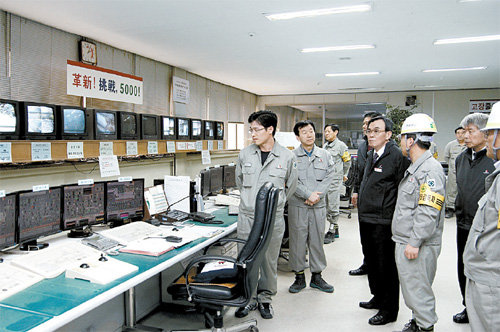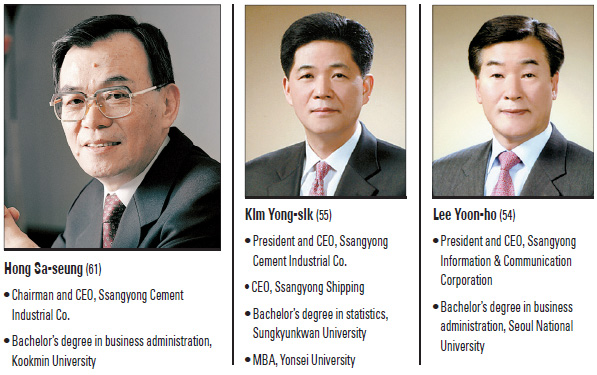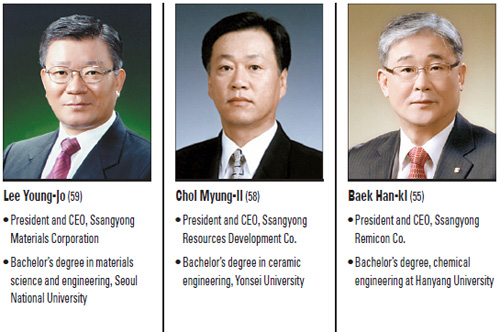The building blocks of Korea

Ssangyong Cement Chairman and CEO Hong Sa-seung, center in black jacket, tours a production line at the company’s plant in Donghae, Gangwon. Provided by the company.
The word “Ssangyong” comes from Chinese characters meaning “two dragons.” And like a pair of dragons soaring upward, the group saw stunning growth from its foundation in 1939 until the early 1990s, when it was among the top six local conglomerates by assets with more than 20 affiliates.
But the decades of prosperity came to a quick end with the Asian financial crisis in the late 1990s, resulting in the disintegration of the most Ssangyong affiliates.


Ssangyong’s largest shareholder is Japan’s Taiheiyo Cement Corporation, which bought into the Korean cement maker in October 2000 as Ssangyong Group was selling off its affiliates.
That event pushed the founding family out of management at Ssangyong Cement. Kim Suk-won, former Ssangyong Group chairman and the eldest son of Ssangyong founder Kim Sung-kon, finally resigned from management at the last of the Ssangyong affiliates in 2004. Though SsangYong Engineering & Construction is still managed by the founding family, Ssangyong Cement claims to be the true successor to Ssangyong Group.
The new professional managers at Ssangyong Cement are led by Chairman Hong Sa-seung, who hopes to find new areas to grow through spending on research and development of environment-friendly products. The company also plans to increase revenues from new businesses, with milestones set up to 2015.
But there are many challenges to face before then. First among them: The local cement industry caters to an oversaturated market. Demand for cement has remained at 50 million tons annually for the last several years, but supply is over 60 million tons.
The global financial crisis took an additional toll. As of 2008, Ssangyong Cement was nearly 1.2 trillion won in debt. It hopes to cut that figure to 600 billion won by next year, reducing its debt-to-equity ratio to under 80 percent.
Kang Seung-min, an analyst at NH Investment and Securities, said the foreseeable future for Ssangyong Cement is bright.
“Expectations are high that the cement industry will recover,” he said, while costs at the company will drop beginning this year as it pays off its bank debts.
Chairman Hong has been with Ssangyong Cement for more than four decades. After joining the company in 1967, he worked his way up the corporate ladder, mostly in the finance department. That experience, the company said, was a big help in stabilizing after the Asian financial crisis.
Ssangyong said Hong plays the role of coordinating the management styles of the Korean company and the Japanese owner, sharing the CEO position with Kim Yong-sik.
Kim became CEO of Ssangyong Cement in February 2009 after serving as the head of the business management and planning divisions at the company. Kim also holds the title of CEO of Ssangyong Shipping, an affiliate founded to transport Ssangyong Cement’s product.
Since February 2008, the head of Ssangyong Information & Communication Corporation, a subsidiary focused on systems integration, has been Lee Yoon-ho. Lee has accumulated experience in fields including overseas businesses, planning and sales in his 30 years with Ssangyong Cement.
Lee Young-jo, CEO of Ssangyong Materials, spent most of his career on production lines, serving as the head of the Yeongweol and Donghae factories. Under his leadership, the company listed its shares on the Kospi stock market last year. Ssangyong Materials makes ceramic industrial goods and exports over 80 percent of its output to 18 countries.
Choi Myung-il, CEO of Ssangyong Resources Development, also served as the head of the Yeongwol and Donghae plants. His current company makes raw materials for cement.
Baek Han-ki was named CEO of Ssangyong Remicon (“ready-mixed cement”) after serving as head of the cement business team and head of the remicon sales team at Ssangyong Cement.
By Moon Gwang-lip [joe@joongang.co.kr]










with the Korea JoongAng Daily
To write comments, please log in to one of the accounts.
Standards Board Policy (0/250자)